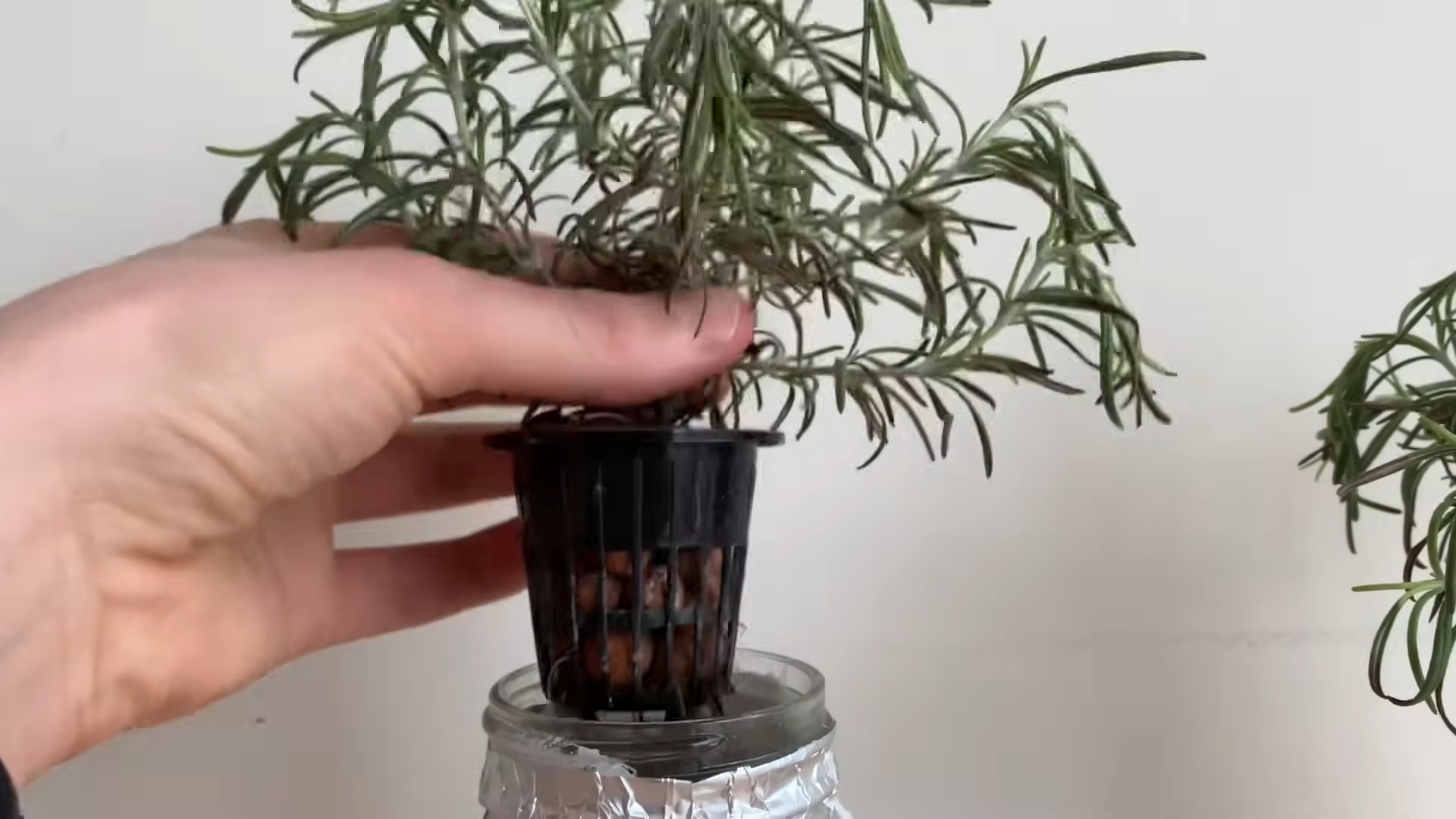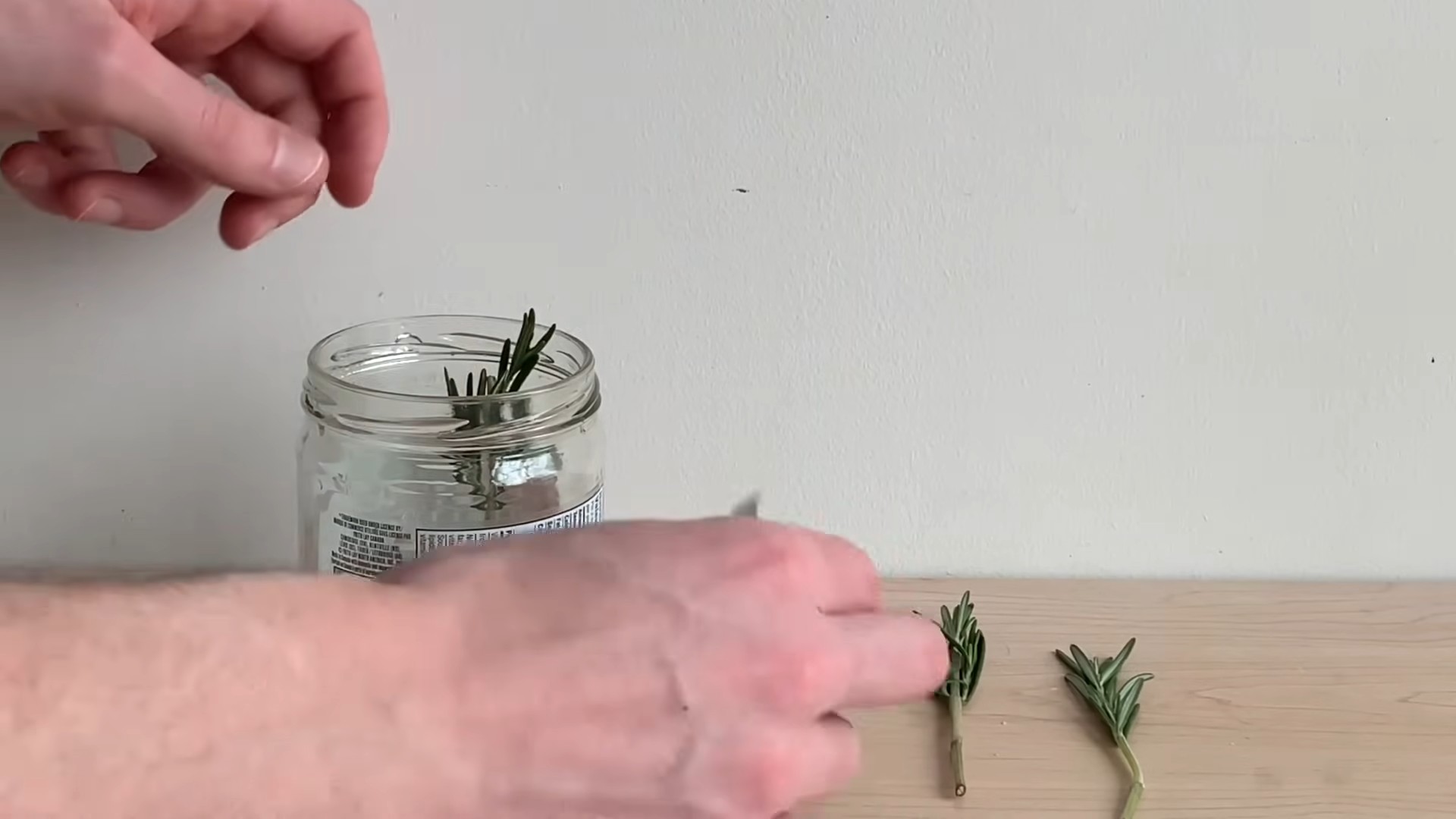Growing Rosemary Indoors can feel like a daunting task, but trust me, with a few simple tricks, you can enjoy the fragrant, flavorful herb right in your kitchen! Imagine having fresh rosemary on hand to elevate your culinary creations, from roasted chicken to homemade focaccia, all year round. No more sad, dried-up sprigs from the grocery store – just vibrant, aromatic rosemary at your fingertips.
Rosemary, with its needle-like leaves and woody aroma, has a rich history. Ancient civilizations revered it for its medicinal properties and symbolic associations with remembrance and fidelity. In ancient Greece, students wore rosemary garlands to improve memory, and it was often burned as incense to purify the air. Today, we appreciate rosemary not only for its culinary uses but also for its potential health benefits and its ability to bring a touch of the Mediterranean into our homes.
But why bother learning these DIY tricks for growing rosemary indoors? Well, for many of us, access to a thriving outdoor garden is a luxury. Apartment living, harsh climates, or simply a lack of time can make outdoor gardening challenging. That’s where these simple hacks come in. I’m going to share my tried-and-true methods for successfully growing rosemary indoors, ensuring you have a healthy and happy plant, regardless of your space or experience level. Get ready to unlock the secrets to a thriving indoor rosemary garden!

Growing Rosemary Indoors: A Comprehensive DIY Guide
Hey there, fellow plant enthusiasts! Ever dreamt of having fresh, fragrant rosemary readily available right in your kitchen? Well, dream no more! Growing rosemary indoors is totally achievable, and I’m here to guide you through every step of the process. It might seem a little daunting at first, but trust me, with a little patience and the right know-how, you’ll be snipping sprigs of rosemary for your culinary creations in no time.
Choosing the Right Rosemary Variety
Before we dive into the nitty-gritty, let’s talk rosemary varieties. Not all rosemary is created equal, especially when it comes to indoor growing. Some varieties are naturally more compact and better suited for containers.
* ‘Blue Boy’: This is a popular choice for indoor growing because it stays relatively small and has a lovely, strong fragrance.
* ‘Roman Beauty’: Another compact variety with a trailing habit, making it perfect for hanging baskets or letting it cascade over the edge of a pot.
* ‘Arp’: This variety is known for its cold hardiness, which can be beneficial if your indoor environment tends to fluctuate in temperature.
* ‘Spice Islands’: A more upright variety, but still manageable indoors with regular pruning. It boasts a particularly pungent aroma.
I personally prefer ‘Blue Boy’ for its manageable size and intense fragrance, but feel free to experiment and find the variety that best suits your taste and space!
Gathering Your Supplies
Okay, now that we’ve chosen our rosemary variety, let’s gather the necessary supplies. This is crucial for setting your rosemary up for success.
* Rosemary Plant or Cuttings: You can either purchase a small rosemary plant from a local nursery or propagate your own from cuttings (more on that later!).
* Pot with Drainage Holes: Drainage is absolutely essential for rosemary. Choose a pot that’s at least 6 inches in diameter to start, and make sure it has plenty of drainage holes. Terra cotta pots are a great option because they allow the soil to breathe.
* Well-Draining Potting Mix: Rosemary hates soggy soil. Use a well-draining potting mix specifically formulated for herbs or cacti/succulents. You can also amend regular potting mix with perlite or sand to improve drainage.
* Grow Light (Optional but Recommended): Rosemary needs a lot of sunlight, and if you don’t have a south-facing window, a grow light will be your best friend.
* Watering Can or Spray Bottle: For gentle watering.
* Pruning Shears or Scissors: For trimming and harvesting.
* Fertilizer (Optional): A balanced liquid fertilizer diluted to half strength can be used sparingly during the growing season.
* Pebbles or Gravel (Optional): To place at the bottom of the pot for even better drainage.
Step-by-Step Planting Guide
Alright, let’s get our hands dirty! Here’s a step-by-step guide to planting your rosemary:
1. Prepare the Pot: If you’re using pebbles or gravel for drainage, place a layer at the bottom of the pot. This will help prevent the drainage holes from becoming clogged.
2. Fill with Potting Mix: Fill the pot with your well-draining potting mix, leaving about an inch of space at the top.
3. Gently Remove Rosemary from Container: If you’re planting a purchased rosemary plant, gently remove it from its nursery container. Loosen the roots slightly with your fingers to encourage them to spread out.
4. Plant the Rosemary: Place the rosemary plant in the center of the pot, making sure the top of the root ball is level with the soil surface.
5. Fill in with Soil: Fill in the remaining space around the plant with potting mix, gently pressing down to secure it.
6. Water Thoroughly: Water the rosemary thoroughly until water drains out of the drainage holes. This will help settle the soil and hydrate the plant.
7. Place in a Sunny Location: Place the pot in a location that receives at least 6-8 hours of direct sunlight per day. A south-facing window is ideal. If you don’t have enough natural light, supplement with a grow light.
Propagating Rosemary from Cuttings
Want to expand your rosemary collection without spending a fortune? Propagating from cuttings is a fantastic way to do it! It’s a bit more involved than planting a purchased plant, but it’s incredibly rewarding.
1. Take Cuttings: In the spring or early summer, take 4-6 inch cuttings from new growth. Choose stems that are healthy and free from pests or diseases.
2. Prepare the Cuttings: Remove the leaves from the bottom 1-2 inches of each cutting. This will prevent them from rotting when they’re in the water or soil.
3. Rooting Options: You have two main options for rooting rosemary cuttings:
* Water Propagation: Place the cuttings in a glass of water, making sure the leaves are above the waterline. Change the water every few days. Roots should start to appear in a few weeks.
* Soil Propagation: Dip the cut ends of the cuttings in rooting hormone (optional but recommended). Plant the cuttings in a small pot filled with well-draining potting mix. Keep the soil moist but not soggy. Cover the pot with a plastic bag or humidity dome to create a humid environment.
4. Wait for Roots to Develop: Whether you’re using water or soil propagation, be patient! It can take several weeks for roots to develop.
5. Transplant (if necessary): If you rooted your cuttings in water, transplant them to a pot filled with well-draining potting mix once the roots are about an inch long.
6. Care for New Plants: Treat your newly propagated rosemary plants just like you would a mature plant. Provide plenty of sunlight, water when the soil is dry to the touch, and fertilize sparingly.
Caring for Your Indoor Rosemary
Now that your rosemary is planted and thriving (hopefully!), let’s talk about ongoing care. Proper care is essential for keeping your rosemary healthy and productive.
* Watering: Rosemary is drought-tolerant and doesn’t like to be overwatered. Water only when the top inch of soil feels dry to the touch. When you do water, water thoroughly until water drains out of the drainage holes. Avoid getting the foliage wet, as this can lead to fungal diseases.
* Sunlight: Rosemary needs at least 6-8 hours of direct sunlight per day. If you don’t have enough natural light, supplement with a grow light.
* Temperature: Rosemary prefers temperatures between 60-70°F (15-21°C). Avoid placing it near drafts or heat sources.
* Humidity: Rosemary prefers relatively low humidity. Avoid placing it in a humid bathroom or kitchen.
* Fertilizing: Fertilize sparingly with a balanced liquid fertilizer diluted to half strength during the growing season (spring and summer). Avoid fertilizing during the winter months when the plant is dormant.
* Pruning: Pruning is essential for keeping your rosemary plant compact and bushy. Prune regularly to remove dead or leggy growth and to encourage new growth. You can also prune to shape the plant to your liking.
* Pest Control: Keep an eye out for common pests like aphids, spider mites, and whiteflies. If you notice any pests, treat them with insecticidal soap or neem oil.
* Repotting: Repot your rosemary plant every 1-2 years as it outgrows its pot. Choose a pot that’s slightly larger than the previous one.
Harvesting Rosemary
One of the best parts about growing rosemary indoors is being able to harvest fresh sprigs whenever you need them!
* When to Harvest: You can start harvesting rosemary once the plant is established and has grown several inches tall.
* How to Harvest: Use pruning shears or scissors to snip off sprigs of rosemary. Avoid cutting more than one-third of the plant at a time.
* Using Rosemary: Fresh rosemary can be used in a variety of culinary dishes, including roasted meats, vegetables, soups, and sauces. You can also dry rosemary for later use. To dry rosemary, simply hang sprigs upside down in a cool, dry place until they are completely dry.
Troubleshooting Common Problems
Even with the best care, you might encounter some problems when growing rosemary indoors. Here are some common issues and how to address them:
* Yellowing Leaves: This can be caused by overwatering, underwatering, nutrient deficiencies, or pests. Check the soil moisture and adjust your watering accordingly. Fertilize if necessary. Inspect the plant for pests.
* Brown Leaves: This can be caused by underwatering, dry air, or sunburn. Water more frequently and increase humidity. Move the plant to a location with less direct sunlight.
*

Conclusion
So, there you have it! Mastering the art of growing rosemary indoors is not only achievable but also incredibly rewarding. We’ve walked through the essential steps, from selecting the right variety and pot to providing optimal light, water, and humidity. But why is this DIY trick a must-try? Because fresh rosemary, readily available at your fingertips, elevates your culinary creations to a whole new level. Imagine the aroma of freshly snipped rosemary infusing your roasted chicken, flavoring your homemade bread, or adding a fragrant touch to your cocktails. No more wilted, store-bought sprigs!
Beyond the culinary benefits, growing rosemary indoors offers a therapeutic connection to nature. Tending to your rosemary plant can be a calming and grounding experience, a welcome respite from the hustle and bustle of daily life. Plus, the vibrant green foliage adds a touch of natural beauty to your indoor space.
But the journey doesn’t end here. Feel free to experiment with different varieties of rosemary. ‘Blue Boy’ is a compact choice perfect for smaller spaces, while ‘Tuscan Blue’ offers a more upright growth habit. You can also explore different potting mixes to find what works best for your environment. Some gardeners swear by adding a bit of perlite or vermiculite to improve drainage, while others prefer a slightly acidic soil mix.
Consider using your homegrown rosemary to create infused oils or vinegars, adding a unique and flavorful twist to your pantry staples. You can also dry your rosemary sprigs for later use, preserving the herb’s aromatic essence for months to come. Another variation is to propagate new rosemary plants from cuttings, expanding your indoor herb garden and sharing the joy of fresh rosemary with friends and family.
Don’t be afraid to experiment and adapt these tips to your specific environment and preferences. The key is to observe your rosemary plant closely and adjust your care routine accordingly. Is the soil drying out too quickly? Increase the watering frequency. Are the leaves turning yellow? Check for signs of overwatering or nutrient deficiencies.
We wholeheartedly encourage you to embark on this rewarding journey of growing rosemary indoors. It’s a simple yet profound way to connect with nature, enhance your culinary skills, and add a touch of beauty to your home.
Now, it’s your turn! Grab a pot, some rosemary seeds or a starter plant, and get your hands dirty. We’re confident that you’ll be amazed by the results. And most importantly, we want to hear about your experience! Share your tips, tricks, and triumphs in the comments below. Let’s create a community of indoor rosemary enthusiasts, sharing our knowledge and inspiring each other to grow the most fragrant and flavorful rosemary possible. What are you waiting for? Start growing rosemary indoors today!
Frequently Asked Questions (FAQ)
1. What is the best variety of rosemary to grow indoors?
While many rosemary varieties can be grown indoors, some are better suited than others. Compact varieties like ‘Blue Boy’ and ‘Roman Beauty’ are excellent choices for smaller spaces, as they tend to stay relatively small and manageable. ‘Tuscan Blue’ is another popular option, known for its upright growth habit and fragrant foliage. Ultimately, the best variety for you will depend on your personal preferences and the amount of space you have available. Consider visiting your local nursery to see which varieties are available and choose one that appeals to you. Remember to research the specific needs of each variety to ensure you can provide the appropriate care.
2. How much sunlight does indoor rosemary need?
Rosemary thrives in bright, sunny conditions, requiring at least 6-8 hours of direct sunlight per day. When growing rosemary indoors, the biggest challenge is often providing sufficient light. Place your rosemary plant near a south-facing window where it can receive the most sunlight. If you don’t have a south-facing window, an east- or west-facing window can also work, although you may need to supplement with artificial light. If your rosemary plant isn’t getting enough sunlight, it may become leggy and produce fewer leaves. Consider using a grow light to provide supplemental lighting, especially during the winter months when natural light is limited. LED grow lights are a great option, as they are energy-efficient and provide the full spectrum of light that plants need to thrive.
3. How often should I water my indoor rosemary plant?
Overwatering is one of the most common mistakes when growing rosemary indoors. Rosemary prefers well-draining soil and doesn’t like to sit in soggy conditions. Water your rosemary plant only when the top inch of soil feels dry to the touch. When you do water, water thoroughly until the water drains out of the bottom of the pot. Be sure to empty the saucer underneath the pot to prevent the plant from sitting in standing water. During the winter months, when the plant is not actively growing, you may need to water less frequently. Always check the soil moisture before watering to avoid overwatering.
4. What kind of soil is best for growing rosemary indoors?
Rosemary prefers well-draining soil that is slightly acidic to neutral. A good potting mix for rosemary should be light and airy, allowing for good drainage and aeration. Avoid using heavy, clay-based soils, as these can retain too much moisture and lead to root rot. You can create your own potting mix by combining equal parts of potting soil, perlite, and sand. Perlite helps to improve drainage, while sand adds weight and stability to the mix. You can also purchase a pre-made potting mix specifically formulated for herbs.
5. How do I fertilize my indoor rosemary plant?
Rosemary is not a heavy feeder, so you don’t need to fertilize it frequently. Fertilize your rosemary plant every 2-3 months during the growing season (spring and summer) with a balanced liquid fertilizer diluted to half strength. Avoid over-fertilizing, as this can lead to leggy growth and a build-up of salts in the soil. During the winter months, when the plant is not actively growing, you don’t need to fertilize it at all.
6. How do I prune my indoor rosemary plant?
Pruning is essential for maintaining the shape and health of your rosemary plant. Prune your rosemary plant regularly to encourage bushier growth and prevent it from becoming leggy. The best time to prune rosemary is in the spring, after the plant has finished flowering. Use sharp, clean pruning shears to trim back the stems, removing any dead or damaged growth. You can also prune your rosemary plant throughout the growing season to harvest fresh sprigs for cooking. When pruning, avoid removing more than one-third of the plant at a time.
7. How do I deal with pests and diseases on my indoor rosemary plant?
Rosemary is generally resistant to pests and diseases, but it can occasionally be affected by common houseplant pests such as aphids, spider mites, and whiteflies. Inspect your rosemary plant regularly for signs of pests or diseases. If you notice any pests, you can try washing them off with a strong stream of water or using insecticidal soap. For more severe infestations, you may need to use a stronger insecticide. To prevent diseases, ensure that your rosemary plant has good air circulation and avoid overwatering.
8. Can I propagate rosemary from cuttings?
Yes, propagating rosemary from cuttings is a relatively easy and effective way to create new plants. Take cuttings from healthy, non-flowering stems in the spring or summer. The cuttings should be about 4-6 inches long and have several leaves. Remove the leaves from the bottom inch of the cutting and dip the cut end in rooting hormone. Plant the cutting in a small pot filled with well-draining potting mix. Keep the soil moist and place the pot in a warm, bright location. The cuttings should root within a few weeks.
9. My rosemary plant is turning brown. What am I doing wrong?
Browning leaves on a rosemary plant can be caused by several factors, including overwatering, underwatering, lack of sunlight, or nutrient deficiencies. Check the soil moisture to determine if you are watering too much or too little. Ensure that your rosemary plant is receiving enough sunlight. If the leaves are turning yellow, it could be a sign of nutrient deficiencies. Fertilize your rosemary plant with a balanced liquid fertilizer. If you have ruled out these factors, it could be a sign of root rot. Remove the plant from the pot and inspect the roots. If the roots are brown and mushy, it is likely that the plant has root rot. You may be able to save the plant by removing the affected roots and repotting it in fresh soil.
10. How do I overwinter my rosemary plant indoors?
If you live in a climate with cold winters, you will need to bring your rosemary plant indoors to overwinter it. Before bringing the plant indoors, inspect it for pests and diseases. Place the plant in a bright, sunny location and water it sparingly. Avoid fertilizing the plant during the winter months. As the days get longer and the weather warms up in the spring, you can gradually acclimate the plant to outdoor conditions.





Leave a Comment